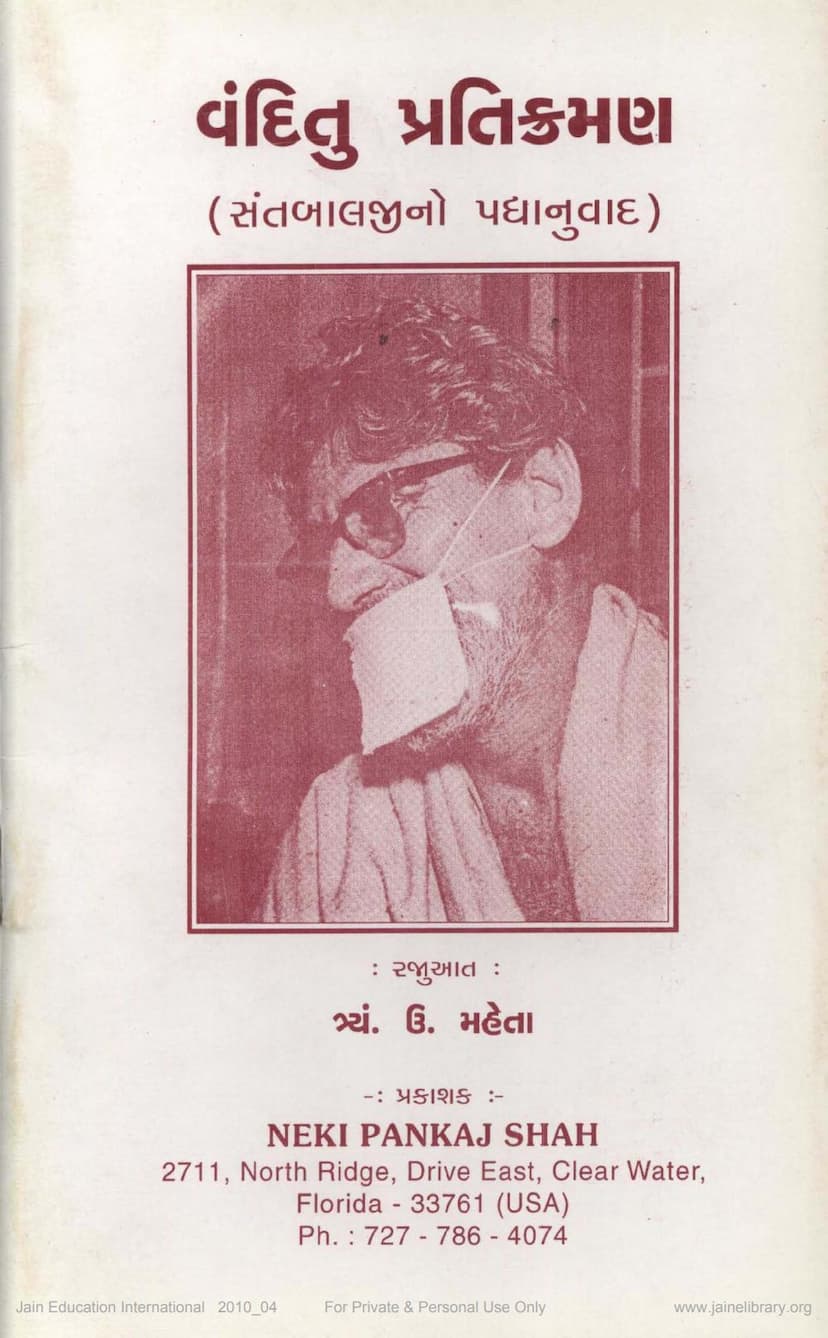Vandittu Pratikraman
Added to library: September 2, 2025

Summary
This document is a Gujarati book titled "Vandittu Pratikraman (Santbalji no Padyanuvad)" by T. U. Mehta, published by Neki Pankaj Shah in Florida, USA. The book is a poetic translation and commentary by Shri Champaklal U. Mehta of a text originally composed by Muni Shri Santbalji.
Here's a breakdown of the content and its significance:
Core Concept: Pratikraman and Samayik
The book begins by explaining two important Jain practices:
- Samayik: A period of 48 minutes dedicated to reading, contemplation, and meditation to achieve equanimity. Jain monks and nuns, being in a perpetual state of equanimity, do not perform Samayik, but householders (Shravak/Shravika) practice it for training.
- Pratikraman: This involves reflecting on actions performed throughout the day (through mind, speech, and body). It includes:
- Alochna (Criticism): Reviewing actions.
- Nindana (Repentance): Acknowledging and regretting mistakes.
- Goyana (Resolution): Resolving to correct mistakes and make new commitments.
- Kshamapan (Forgiveness): Seeking forgiveness from the divine (Arihant, Siddha, Acharya, Upadhyay, Sadhu) and all living beings. It emphasizes seeking forgiveness immediately after realizing a mistake.
Muni Shri Santbalji's Contribution
Muni Shri Santbalji is presented as a unique and revolutionary thinker with a vision of structuring human society based on religious principles. He deeply studied Jain and non-Jain literature, extracting essential truths without compromising them. He aimed to address modern societal issues.
His "Vandittu Pratikraman" is an attempt to present the core essence of traditional Pratikraman in a way that is accessible and relevant to modern householders, moving it beyond sectarian limitations. He defines Pratikraman as: "From one's own place, going to another place due to negligence, returning again is called Pratikraman." This is explained as the soul leaving its true nature (knowledge, perception, conduct) due to passions like anger, greed, ego, and attachment, and then returning to its pure state.
Shri Champaklal U. Mehta's Role
Shri Champaklal U. Mehta, a retired Chief Justice, has provided a detailed commentary and explanation of Muni Shri Santbalji's poetic translation. His goal is to make the concept of Pratikraman understandable and appealing to a wider audience, including both Jains and non-Jains. He highlights that Pratikraman is fundamentally an introspective process focused on self-purification, not dependent on any external deity.
Structure of "Vandittu Pratikraman"
The book details the content of Muni Shri Santbalji's "Vandittu Pratikraman," which comprises 48 verses (Gathas). These verses cover various aspects of Jain ethics and practice, including:
- Verses 1-2: Salutations to the enlightened beings (Vitarag).
- Verses 3-7: Reflection on faults related to perception, knowledge, and conduct, and the process of karma binding.
- Verses 8-13: Detailed exploration of the five vows (Ahimsa, Satya, Asteya, Brahmacharya, Aparigraha), their transgressions, and the importance of self-reflection.
- Verses 14-15: Discussion of the twelve vows for householders (five sub-vows, three vows of augmentation, and four vows of discipline), and the impact of passions.
- Verses 16-18: Focus on Ahimsa (non-violence), emphasizing its expansive nature and the importance of intention and careful practice.
- Verses 19-20: Focus on Satya (truthfulness) and its connection to Ahimsa.
- Verses 21-22: Focus on Asteya (non-stealing) and its broader implications in business and societal responsibility.
- Verses 23-25: Focus on Brahmacharya (celibacy/chastity), emphasizing respect for all women and the concept of maintaining purity of thought and action, even within household life. It also touches upon the historical context of this vow.
- Verses 26-27: Focus on Aparigraha (non-possession) and controlling desires and attachments.
- Verses 28-31: Explanation of the three vows of augmentation (Diksha Pariman, Bhog Upbhog Pariman, and Anarthadand Virman) and their role in supporting the five vows.
- Verses 32-34: Explanation of the four vows of discipline (Samayik, Deshavkashik, Paushadh, and Atithi Samvibhag), emphasizing equanimity, self-restraint, and detachment.
- Verses 35-38: Focus on maintaining equanimity in all situations, the importance of devotion, respecting others, and practicing detachment.
- Verses 39-40: Discussion of the five Samitis (careful conduct) and three Guptis (restraints) as "Pravachan Mata" (mothers of the teachings) for a disciplined life.
- Verses 41-45: Explains concepts like Asrava (influx of karma), Samvara (cessation of karma), and the state of Kevali (omniscient beings), and the ultimate goal of liberation.
- Verses 46-47: A plea for spiritual seeds (Bodhi Beej) and divine support.
- Verse 48: A prayer for forgiveness and universal well-being.
Emphasis on Self-Reflection and Universalism
The book strongly advocates for introspection and self-correction. It highlights that true progress lies in understanding and rectifying one's own faults rather than blaming others or seeking external salvation. Muni Shri Santbalji's approach is described as universal, aiming to benefit all of humanity by promoting ethical living and self-awareness.
The practice of Kayotsarg (Austerity of the Body)
The book also includes a detailed explanation of Kayotsarg, a key element within Samayik. It defines Kayotsarg as forgetting the body and realizing the self, detaching from worldly activities and emotions, and concentrating on the true, eternal nature of the soul. Various meditation techniques are suggested for achieving this state.
Author's Profile
The book concludes with a brief profile of Shri Champaklal U. Mehta, highlighting his distinguished career as a retired Chief Justice and his active involvement in public affairs and philosophical studies, particularly in Jainism and comparative religion.
In essence, "Vandittu Pratikraman" is a comprehensive guide to understanding and practicing Pratikraman in a modern context, drawing upon the wisdom of Jain philosophy and the interpretive efforts of its authors to make it relevant and accessible to contemporary readers.